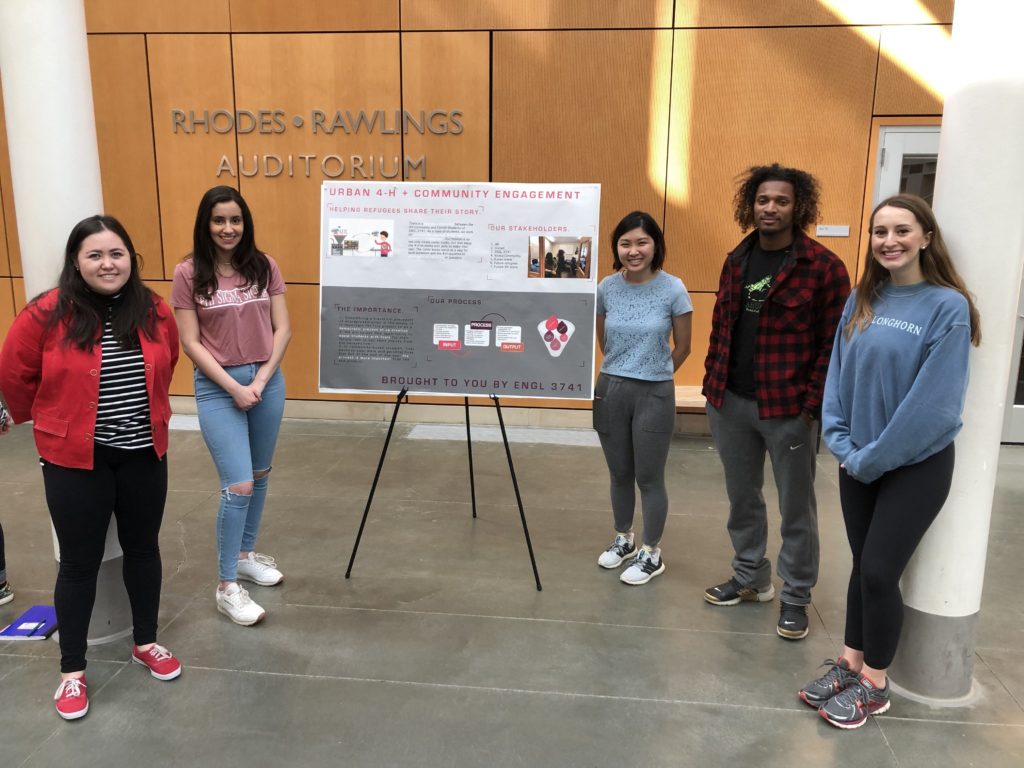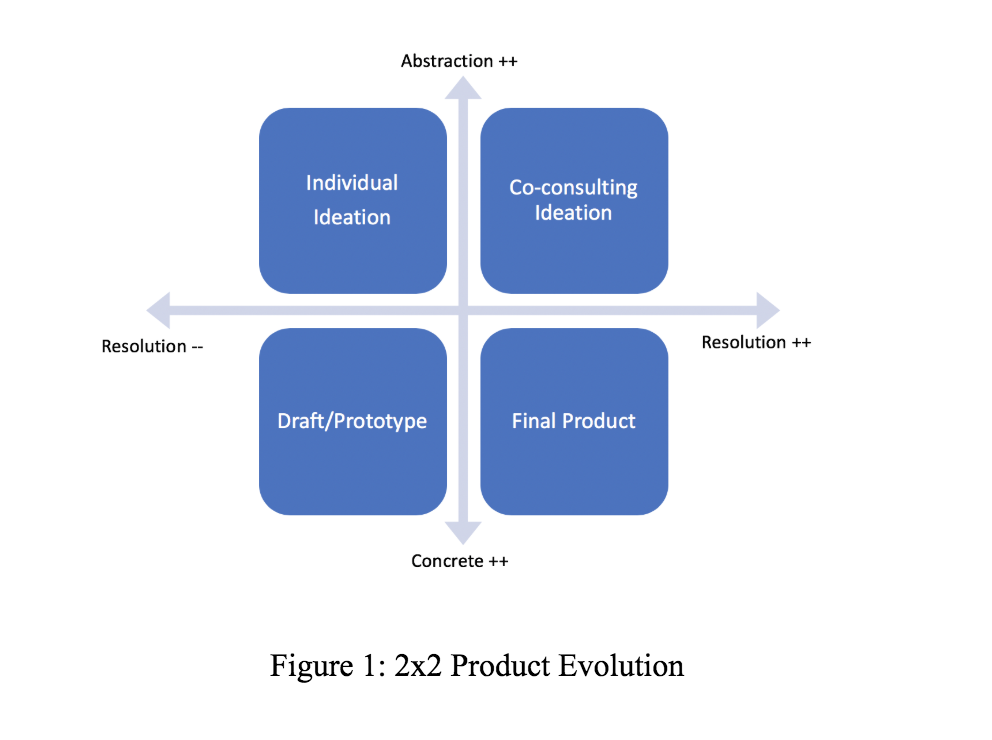
About the Student Team
The group of students working with the Urban 4H community center began their engagement with the teens by spending several visits getting to know the students, and working to create a trusting relationship. Due to the personal nature of the topics chosen for comics, this piece of the collaboration process was critical. Many members of the Cornell group felt that it would have been beneficial to have additional visits that further established the relationships; but because of time limitations, later site visits had to be used as workshops for comics and presentations. Despite the limitations of our class, our collaboration with the Urban 4H Community Center was incredibly helpful in getting feedback on both our design process, and our final products which we presented to the class on the last visit.
Introduction
Media, Design, and Engagement (ENGL 3741) is a class built around community outreach and engagement. Our main project for the semester revolves around providing support and engaging in a co-consulting process with the Cornell Cooperative Extension of Tompkins County 4-H Urban Outreach Program (referred to as Urban 4H) in the creation of comics depicting the stories of the teens from the Urban 4H. The teens would participate in the co-consulting process by providing feedback on our own comics which we are developing as a part of the class. Our team is built out of Cornell University students from all different backgrounds and majors which provides our group with unique insights on a multitude of topics.
The Urban 4H’s focus is detailed in their Mission Mandates as “Citizenship”, “Healthy Lifestyles”, and “Science, Engineering, and Technology”. These missions are accomplished through daily after school programs and summer educational enrichment for the children growing up around the community center. The Urban 4H relies on a mix of state and county grants, donations, and seasonal fundraisers to keep their program going. They have provided support for the children growing up in the area for forty years, and have continued to build out their program to include more support for the teens who have started making the move to higher education.
The bulk of the 4H program is made up of teen refugees .They came from the Karen ethnic group from Burma (Myanmar) who fled Burma to escape cultural and ethnic persecution by the government. Karen villages in Burma were located in forests and were strategically hidden, but during the conflict they were attacked and burned down by the burmese military. Those who were able to escape crossed the border into Thailand, and then were dispersed to several refugee camps across the country. Some of the teens in the Urban 4H are among the estimated 50 Karen refugees now settled in Ithaca, while the remaining bulk were born in Ithaca shortly after their parents arrival in Ithaca.
Our job as Stories beyond words was to engage in the co-consulting process in a way that would benefit both the 4H teens and our firm. Drawing from the Art of Transformation, we understood going in to this that we need to allow the teens to have control in this project. We wanted them to tell the stories they wanted to tell, and it was important to respect their narratives and provide support in the creation of their media.
In the following paragraphs we will describe the co-consulting process we went through with the Ithaca Urban 4H and our reflections and recommendations from the experience.
Co-Consulting Process

To create our comics, we employed design thinking techniques. We used our own fields of study, such as Industrial and Labor Relations, Government, Environmental and Sustainability Sciences and Information Science. Traditionally, universities teach highly specialized knowledge, but lack a component of engagement to connect the specialized knowledge with the public. In this case, the main target group was teenagers. We hoped to connect teenagers with our fields of study by creating comics, via a co-consulting process with Urban 4-H at Northside Community Center.
The process to co-create these designs followed a project evolution schematic on a 2×2 graph. From working from highly abstract, intellectual knowledge, the group eventually created concrete fully, formed comics. While our process was more linear, the teens at 4-H appeared to move back and forth between ideation and delivery. The media frame that we have depicted below depicts how projects can move back and forth different phases, and that the process is iterative until the product is satisfactory.
Hear
For our first meeting, we met the teens without having any other intention other than to get to learn them better. We learned about their background as refugees or children of refugees, their interests and where they were in life. We desired to learn and empathize with them, so as to be able to eventually cater to their interests with our comics, but also know how we could help them in creating their own.
After which, we heard the ideas of both our peers and the teens. The teens also heard our ideas regarding the comics. At this stage, all of us were at the top, left hand corner box of our Project Evolution 2×2 graph, with highly abstract ideas without a fully formed product. We heard what the teens liked and did not like, and tried to re-work our ideas without having had created anything. We desired to ‘fail fast’ so as to be quickly re-think our ideas before prototyping.
Create
Second, we created a draft for the comics and brought that draft to our professor, peers and the teens to critique. At this stage, we also helped teach the teens about UX design CAT thinking. Over the weeks, we worked in the computer labs with the students. At the end of the Semester, the teens presented their work along with ours. We taught them mainly the technical aspect of CAT, through teaching and guiding them about how to use ComicLife to build their comics. We also helped them conceptually, trying to help them create a stronger storyline as they started building their comic. For example, We one teen inserted many images in her comic with strong aesthetic design with dark colors. We helped prompt her to think about how she desired to move forward with the comic. In the end, she decided to create a comic about how the main character escapes to a new world that is happier – marked by brighter colors – than the original dull, dim world she was originally in, marked by the darker aesthetic she originally had. In another comic, a teen wrote a story about the significance of soccer with his favorite soccer players. For the conceptual part, we worked on helping the teen make the terms of soccer more accessible, such that everyone can understand what was going on in the comic. For the aesthetic and technical parts, we helped the teen work on how to insert images of his favorite soccer players and edit backgrounds and colors of the comic.
Some examples of how this co-consulting experience aided our comics are listed below. In Alice’s comic, the teens mentioned a strong interest in certain anime characters and to embody water as a real life character to help empathize with water as a living resource. She then decided to incorporate famous anime characters, such as Bakugou from Boku no Hero Academia, and used a water spirit in the comic to meet their interests. These proved useful because they became interested in the subject matter through the medium of comics.
Sarah’s comic centered on the gender pay gap and how biases in high school leadership experiences contribute to this disparity. Through the co-consulting process, she found that the concept was easily relatable to the female teenagers, who had witnessed instances of female candidates dismissed as bossy. However, the engagement and buy-in from the male teenagers was not as apparent. Listening to the positive reception from female teenagers and muted reception from male teenagers, Sarah was able to modify her story to ensure better engagement from teenage boys. By framing the biases as perpetuated by both boys and girls, it removed any sentiment that the comic was villainizing teenage boys. Sarah also included more narration directed at the reader to help them situate the learnings within their own life and better understand how these biases could impact their own friends, male or female.
In Caleb’s comic, he uses animals to depict a story that shows how important inclusive education is. The 4H teens played a critical role in the development process as their feedback greatly shaped the final product. The comic started off with human characters, that were discussing the complexities of their identities and how it correlated with their educational opportunities. While Caleb did a good job giving a breadth of knowledge on his topic with dialogue and evidence, he made a sizeable oversight when he reanalyzed who his audience was. After presenting the first draft, the teens told him it would need to be heavily simplified in order for its meaning to be conveyed to that audience. As a result, Caleb changed the characters and their dialogue and layout. Ultimately, he learned that a wealth of knowledge has no relevance if it can not be transferred effectively.
Megan’s comic was centered around the importance of youth civic engagement and voting. She originally pitched a very realistic idea of a young boy learning about the fight for civil liberties through speaking with his grandfather, but the teens provided sharp feedback. They reminded her that this was a comic marketed towards teens that weren’t as interested in this subject as she was. They suggested that she add a fantastical aspect in order to grab the attention of the reader. These comments were used in her final draft as she created a dream sequence that centered around the story of an alien race fighting for and losing their civil liberties, a much more poignant reminder of what there is to lose rather than what had happened in the past.
Deliver
Lastly, we delivered the comics at a final presentation. During this presentation, we enjoyed listening to both the teens and our peers speak about their final product. Ultimately, the comics may not have been the final product but the process of cultural organizing. The relationship allowed the teens to participate in our comics such that they also had a say in the storytelling. The teens presented their comics, and embedded UX thinking when explaining their comics, such as their conceptual design. We also advised and gave them prompting questions for their own comics, so that they could represent themselves truthfully. We were careful not to act from a position of power, and desired this co-consulting relationship to be equal and informative.
Recommendations
Through this initial trial, we believe there are several improvements that can be made to improve the co-consulting relationship and co-design process. The following are recommendations for future iterations of this partnership:
- Addressing Technological Constraints | We should bring 4H students to Cornell for increased access to computers. This increases the transparency between the two communities, since this iteration of the partnership did not afford the refugees any opportunities to experience our environment as Cornell students. A democratic and vulnerable process not only strengthens the underlying relationship but is critical for cultural organizing, as is indicated in The Art of Transformation.
- Creating One Collective Comic | The refugees may gain more value by creating one comic to represent their collective narrative rather than individual comics. By doing so, they have the opportunity to participate in a democratic process that portrays their story more accurately than traditional media without each individual having to be vulnerable. This increases the value for them as stakeholders, as both teens and the Karen refugee community. It also emphasizes the importance of cultural organizing as a collective process.
- Increasing Opportunities for Funding and Incentives for Student Involvement| Another one of our key recommendations would be bringing the Project Team Model to the humanities, and in particular community engagement as intersects with media and design. What inspired this recommendation was the reading about Collective Cultural Action, and its call for artists to “abandon individual genius and siloed studio” in exchange for more group or team based work. In productivity and effectiveness studies, research has shown time and time again that team based work groups are generally more productive and more satisfied with the work they do. We are proposing that in the particular case for ENGL 3741, the class adopts a project team model in the form of a club or student organization. The 2 main reasons for why we believe this is a worthwhile recommendation are: Increased Access to Funding, More Incentives for Participation for Students. Ultimately, we feel that from these 2 main components more can arise, which will lead to an overall increased effectiveness for Community Engagement Initiatives. This would further the lasting impact on the organizations and people we work with. The increased funding would come from our rights as a student organization to request and receive funding from SAFC and other student run funding boards. This would be important as it could allow for an increased budget for our projects and engagement initiatives. The incentives for students would come from the ability to list a club/position on a resume rather than a class. This is mutually beneficial because with this incentive of a resume booster, the class can demand a higher degree of commitment just like a club would of its members. In conclusion, we believe that we can actualize meaningful and compelling Collective Cultural Action through the creation of corresponding clubs and organizations in conjunction with community engaged classes and projects.
With implementation of these recommendations, we hope future iterations of this project will create a relationship that is more conducive to the core of a co-design process: a relationship that is democratic, creative, and focused on emboldening muted narratives.
